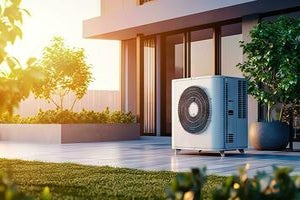
Your heating, ventilation, and air conditioning (HVAC) system is the heart of your home. That’s why it’s important to make sure it’s in top working condition throughout the year. Luckily, whether you’re an experienced DIYer or just looking for a few tips, there are some easy and inexpensive things you can do in the short, medium, and long term to keep your HVAC system happy and healthy.

The importance of maintaining your system
“Most of us use our furnace or air conditioner almost every day,” says Ben Sauve, owner of Sauve Heating & Air Conditioning in Prescott, Ontario. “Regular maintenance can extend the life of your HVAC system, improve your indoor air quality, lower your energy bills, and keep your system running smoothly in every season.”Not maintaining your HVAC system properly could also void your manufacturer’s warranty, warns Nicholas Perreault, Maintenance and Warranty Coordinator with Presidential Ventilation in Mount Uniacke, Nova Scotia.“Most manufacturer warranties require HVAC systems to be maintained annually,” he explains. “Not maintaining your system properly may void your warranty, and end up costing you more.”
Short-term maintenance tips (weekly, monthly, bi-monthly)
But what does maintaining your HVAC actually involve? In the short term—on a weekly, monthly, or bi-monthly basis— you can maintain your HVAC system by carrying out simple tasks like:- checking smoke and carbon monoxide detectors monthly;
- check your air filters monthly, and replace as needed;
- keeping indoor vents and registers clear of clutter, and making sure your registers aren’t accidentally pushed closed;
- vacuuming or brushing off registers, vents, and outdoor HVAC units every few weeks to remove dust or debris, and leaving at least two feet (60 centimetres) of clearance around outdoor air conditioning units and heat pumps; and
- monitoring your monthly energy bills to watch for any spikes in consumption that could indicate a problem.
 Image via Sauve Heating & Air Conditioning
Image via Sauve Heating & Air ConditioningMedium-term maintenance tips (yearly)
Over the medium term—think yearly rather than monthly— several other issues can pop up that will need attention. To avoid unnecessary breakdowns or repairs:- invest in a programmable thermostat;
- clean your air conditioner’s evaporator coil and drain line yearly before the heat sets in;
- check your heating system once a year for leaks, and seal any gaps around windows, doors, and ductwork; and
- hire an HVAC professional to inspect your entire system once or twice a year to prevent serious problems before they occur.

Maintenance tips for the long term (every two years or so)
Lastly, to help keep your energy bills low and your HVAC system running well over the long run:- have your furnace gas line inspected by a professional every few years;
- have your ducts inspected and cleaned by a reputable provider (be leary of unsolicited phone calls) every two to three years, and after any large renovations;
- if your HVAC system is 15 to 25 years old (or older), consider upgrading to a more modern system before it breaks down; and
- when it comes time to buy a new system, ask questions about energy efficient options available to you and suitable for your home and lifestyle – like a heat pump.

Warning signs of trouble
Even the best-maintained system will eventually run into problems. The key is to take care of them as soon as possible.“Ignoring a problem will only make things worse,” Sauve says. “It can also make other components work harder or become more difficult to repair.”You can spot most issues just by keeping your eyes and ears open. For instance, common warning signs of potential trouble with your HVAC system include:- reduced airflow;
- uneven heating and cooling;
- strange noises or smells coming from the system;
- frequent cycling (the system turning itself off and on);
- difficulty keeping your home warm in the winter or cool in the summer; and
- sudden increases in your monthly utility bills.
 Image via Presidential Ventilation
Image via Presidential VentilationHow to troubleshoot common problems
Most HVAC issues are better left to a professional. But there are a few things you can try on your own. For example, if your system isn’t working efficiently:- clean or replace your air filter;
- make sure the vents and registers aren’t obstructed;
- check if the furnace has power. Check the furnace switch and if the breaker/fuse needs to be reset; and
- make sure the thermostat is turned on and set properly, and replace the batteries if needed.
 Image via Sauve Heating & Air Conditioning
Image via Sauve Heating & Air Conditioning